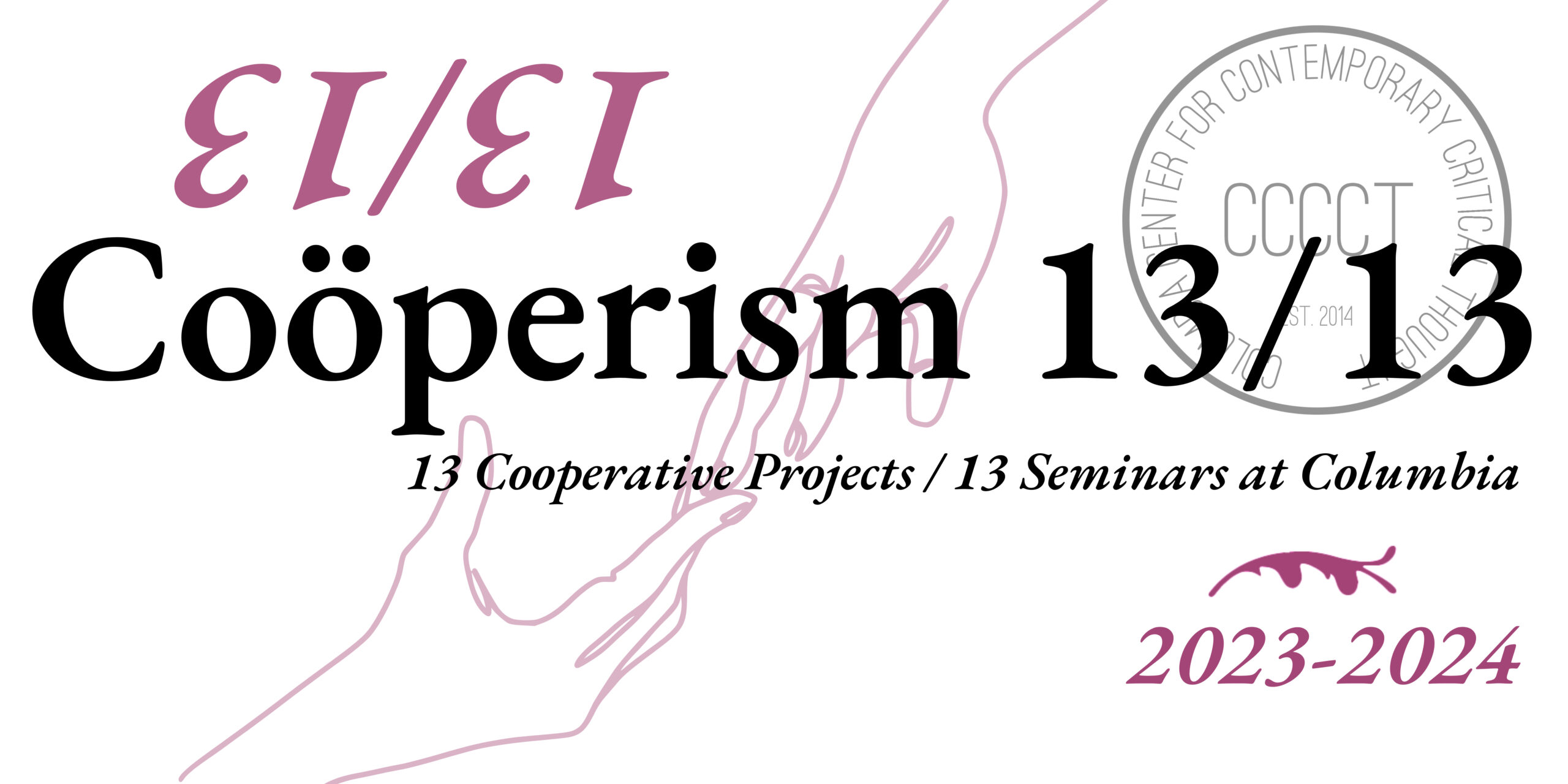By André Pettman
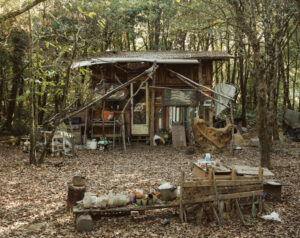
A cabin on the ZAD at Notre-Dame-des-Landes (Photo by Immo Klink)
A “cabane,” or cabin, is a kind of dwelling that, when compared to other spaces of inhabitance, is a relatively poor one. Generally quite small, and rudimentary in its design and construction, a cabin is composed of found materials, such as debris or discarded objects, as well as natural materials, such as branches, mud or stones and, therefore, requires little to no money to build and can be constructed by hand. It is often associated with slums or shanty towns that proliferate in metropolises and tends to be thought of as being a primitive refuge for the highly impoverished. In its longer history, however, the cabin has been associated with individualism and with a retreat from civilization into solitude, thus becoming linked with primitivism, anti-modern and conservative politics, and a more generalized desire for an almost mythical return to origins, or at the very least for a deindustrialized, non-technological existence. Against this backdrop, the cabin certainly dialogues with a history of neoliberalism and its ideological tenets of individualism, self-reliance, and personal responsibility. In France, however, the cabin has emerged in an entirely different frame, becoming a prominent concept of contemporary French Leftist political thought, due in large part to their proliferation across the territory of Notre-Dames-des-Landes during the lengthy, highly-mediatized struggle of the “zone à défendre” (ZAD).
The story of the ZAD begins in the late 1960s. Looking for a territory upon which to construct an airport, the French state earmarked Notre-Dame-des-Landes as a different kind of ZAD, a “Zone d’Aménagement Différé” (future development zone). The plans to build the airport were repeatedly delayed, however, until the early 2000s, before being fully set into motion in early 2008. The revival of the project was met with outcry and opposition from the public, and protestors began to gather and organize the occupation of the territory to delay the airport’s construction. This occupation slowly grew, flourishing into the establishment of an autonomous community with no connection to or dependency on the French State. Occupants built cabins, pitched tents, parked caravans, and set up various structures – such as a bakery, a first aid post, a pirate radio station, and numerous vegetable plots. They were also involved in numerous clashes with the police, blocking off the territory with barricades and preventing the entry of the authorities in spite of a number of largescale attempts at evacuating and demolishing the ZAD. The biggest of these attempts was dubbed by the French government as “Opération César,” an armed, forced evacuation of the inhabitants of the ZAD in October 2012, during which a number of structures and cabins were totally destroyed. In response, the ZADistes mounted fierce resistance, erecting barricades, fences, and other obstacles to keep the police at bay, and beating them back by launching projectiles of various kinds (such as stones, mud, bottles, debris, etc.). They received a groundswell of support, with tens of thousands of people flocking to the ZAD in November 2012 to reoccupy and rebuild the zone. After over a month of conflict, Opération César ceased. The end result was the population of the ZAD doubling in size and the reconstruction of the zone as well as the establishment of new dwellings. The saga of the ZAD seemingly came to an end in 2018, when it was announced that the construction plans for the airport had been definitively halted.[1]
I would like to focus on the significance of the cabin in the context of the ZAD at Notre-Dame-des-Landes. Tarrying with the cabin allows us to draw out some of the different forms of cooperation and praxis enacted on the ZAD, as well as some of the principles that undergird the movement’s ethos. In what follows, I meditate on four different forms of cooperation and praxis. I begin by thinking the cabin as both a means of resistance and as a means of cultivating community. I then move to a discussion of how the cabin helps us engage with the ZAD’s ecopolitical thought, before closing with a consideration of the cabin as a space of political possibility and imagination.
* * *
Cabins & Conflict
As an inherently precarious structure, a cabin does not immediately spring to mind as a particularly viable tool of resistance. On the ZAD, however, this precariousness is what gives the cabin its salience as an important strategic element of political praxis. By being easily constructed and deconstructed, as well as architecturally amorphous, a cabin can be used both as a mobile base and shelter that is resistant to permanent demolition. As the police destroyed cabins in the ZAD, its inhabitants would swiftly rebuild them. On a territory the size of the ZAD, the relative speed and ease with which a cabin could be built offered occupants a strategic flexibility, for it allowed them to circulate throughout the territory more freely, as opposed to tying them to one area. In constantly circulating, in being able to destroy a cabin just as much as building one, occupants became difficult to pin down and thus that much more resistant to the control, surveillance, and discipline of the state. In becoming indistinguishable from the territory through which they circulate, occupants were able to meet, organize, and strategize without as much concern of being apprehended by the watchful eyes of the police. They were, to a certain degree, able to disappear into the topographical folds of the ZAD’s territory. Once this armor of opacity and illegibility was pierced, one was required to move, fleeing fixity and visibility, and thus re-scrambling the state’s ability to “read” the territory and predict and control the free circulation of the bodies that help compose it. Therefore, if one wishes to completely disappear, building a cabin always involves its inevitable destruction and reconstruction elsewhere.
On the ZAD, cabins were built and re-built on the ground and in the trees of the forest, much like the “tree-sits” constructed by those defending the Weelaunee Forest in South Atlanta. As such, occupants were able to use them as observation posts from which the territory could be surveyed, allowing them to see below, around, and above. From this vantage point, they were able to detect the approach of the police and prepare their oppositional tactics. This also allowed occupants to spread out and attack the police from multiple angles, thus strengthening their offensive measures. Such a diffuse and unpredictable form of resistance made it much harder for the police to fully penetrate the territory and destroy the ZAD’s structures. In spreading out and moving through the territory, occupants not only had a strategic advantage when it came to fighting the police, it also afforded them more time to re-build and re-establish shelters, bases, and networks of cabins that may have been destroyed during conflict.
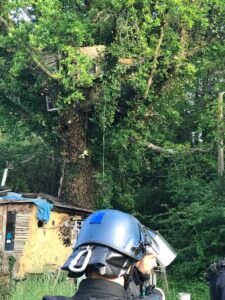
French riot police stand below a cabin in the trees on the ZAD at Notre-Dame-des-Landes (Photo by Twitter User @JFrancoisMartin)
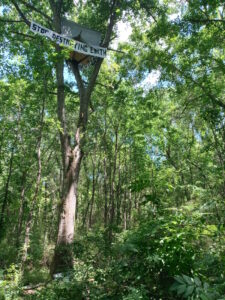
A tree sit in the Weelaunee Forest in South Atlanta (Photo from Wikimedia Commons)
Cabins, Community, Communality
While the cabins that dotted the territory of the ZAD were markers of resistance that symbolized a clear, material oppositional stance towards power and the police, they were also material signs of an autonomous form of community. Indeed, as the participant research collective Mauvaise Troupe write in their text The ZAD and NoTAV: Territorial Struggles and the Making of a New Political Intelligence, the cultivation of community went hand-in-hand with the defense of the territory: “Defending the zone was as much about preventing the advancement of Caesar’s troops as about reoccupying. A village emerged in two days in a hollow in the chestnut forest. New cabins appeared each week in the trees after the others had been torn down”[2]. The community of the ZAD was markedly heterogeneous, as it brought together people from all walks of life, regardless of occupation, gender, race, age, class, etc., thus symbolizing what Kristin Ross calls the “phenomenon of solidarity in diversity”[3]. For example, occupants ranged from anarchists, situationists, autonomists, primitivists, and feminists, to punks, ecologists, and undocumented peoples to nuns, farmers, lawyers, and vegan lesbian separatists[4]. On a strategic level, the heterogeneity of the ZAD’s inhabitants allowed for “the deployment of an array of different ways to block the project […] This plurality has the advantage of rendering the movement as difficult to circumscribe as it is unpredictable”[5].
This refusal of delimitations also shaped the ZAD’s communal form, as the territory was seen as a space in which any occupant could situate themselves in the territory in some way, shape, or form “that is not only merely symbolic, but open and material”[6]. Thus, the question changes from one of ownership to one of common use. What is fostered by this shift is not a commonality that seeks to consolidate different kinds of use in order to arrive at a set of identical goals or practices. Rather, what is cultivated is a communality “in which each individual is nothing but what connects him or her to the land and to others”[7]. The emphasis of communality over commonality also discouraged the establishment of any kind of vertical power structure. Instead, it engendered a horizontality that helped build connections between groups and was an integral component of a collective process the Mauvaise Troupe Collective refers to as “composition,” that is, the perpetual forging of community while preserving the heterogeneity of practices and perspectives circulating within it. The community of the ZAD was animated not by the possession of a territory, but by the relations and bonds between occupants and the world they shared in common.
Due to its remarkable heterogeneity, the community of the ZAD was made up of a number of different, smaller communities, functioning as a kind of federation of communes. Of course, such heterogeneity also lent itself to the emergence of dissonance between different occupants. Reflecting on his time on the ZAD, photographer Philippe Graton describes it as a communal space in which friction was commonplace. While disagreements would arise, for example, during larger decision-making assemblies or in regard to how materials or spaces were to be used, he makes clear that these quarrels subsided when it came to defending the territory from the police[8]. A similar dynamic of disagreement and cooperation is described in accounts of Defend the Atlanta Forest/Stop Cop City, with occupants refusing institutional mediation to quell dissensus, developing instead “customs and practices of compromise and conflict resolution”.[9] As such, the ZAD and the Weelaunee Forest are sites of what Yves Citton calls a “politics of convivial dissensus,”[10] which welcomes heterogeneity as a stimulating force that may create differences without impeding the cooperation and general functioning integral to communal life and resistance.
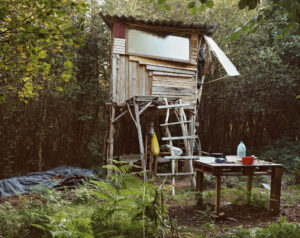
A cabin elevated from the ground on the ZAD at Notre-Dame-des-Landes (Photo by Immo Klink)
The Ecopolitics of the Cabin
The cabin also makes an ecopolitical gesture by way of its structural precarity, one that nurtures and hinges on an attention to and care for forms of life in their multiplicity. As Isabelle Galichon has argued, the cabin mirrors the vulnerability of all forms of existence, whether they be human, animal, environmental or otherwise[11]. As such, it brings to the fore the precarious lives of those living in, for example, refugee camps or tent cities, highlighting their insecurity and injustice, thus making a gesture of consideration, compassion, and solidarity. While the violence and oppression to which precarious lives are subjected should be roundly condemned, this does not require the concomitant condemnation of precarity as such. Indeed, to argue for the total elimination of precarity within the frame of contemporary governance is to perpetuate the illusory belief that precarious lives can be protected by the very same power structures responsible for the production of precarity. Rather, the cabin signals that there is dignity and autonomy located in precarity, especially in a communal, cooperative form. The ZAD demonstrates the possibility of developing alternative modes of knowledge production, self-sufficiency and self-governance, and of inventing, in the words of political theorist Isabell Lorey, “new forms of protection that do not consist in the immunizing warding off and negating of vulnerability and contingency”[12].
By virtue of the fragile border it creates vis-à-vis the outside world, the cabin also brings its occupant(s) into closer contact with the precariousness and vulnerability of its surrounding environment. Thus, to inhabit a cabin is not to cut oneself off from the world; it is to come into more intimate contact with it, to affirm the reciprocal, cooperative relation between oneself and the world. The ethos of communality that shapes this relationality is further evidenced in writings that have emerged from the ZAD. Its occupants made it clear that they were neither defending nor preserving “nature,” because the territory upon which the ZAD is situated is entirely unnatural, as it is the result of capitalist intervention. Previously a commons, the territory is now a 4,000-acre bocage, a kind of landscape made up of a mix of forests, wetlands, hedgerows, and fields. The bocage came into being through a process of territorial privatization and parcellation; its ecological features are evidence of this process of land management, with its hedgerows initially conceived as a form of enclosure and material form of division. When the airport project was delayed the territory was left unattended, and so local farmers began to collectively cultivate and tend to the land in the interim. As such, the territory is an odd synthesis of capitalist violence and human care, corresponding with “the end of communal usage of land” while also being “the result of neither man nor nature alone but of their alliance”[13]. What the occupants of the ZAD were defending is this alliance, the interconnection and cooperation of man and the environment. They were not only defending a territory, they were also defending a relation to the world and the variegated beings and forms that compose it[14].
The practices of the ZAD clearly distinguish themselves from other kinds of “environmentalism” whose focus is on the preservation of resources as separate and distinct from human subjects. On the contrary, what we see here is an articulation of environments and ecologies not as containers in which individuals exist and circulate, but rather as plural entities with which we are enmeshed in profound interrelation. This aligns, in the main, with Félix Guattari’s theorization of an “ecosophy” which refuses the artificial separation of the human and non-human and argues, instead, for an understanding of three ecological registers (the environment, social relations, and human subjectivity) as inseparable and in constant interaction. From an ecosophical perspective, the defense of a territory such as the ZAD is not contingent on the presence of useful resources for consumption. Rather, the question of territory is approached with an openness, a willingness to be vulnerable and exposed to the possibilities of its multiplicities. Following Guattari, a territory is, at once, “precarious, finite, finitized, singular, singularized, capable of bifurcating into stratified and deathly repetitions or of opening up processually from a praxis that enables it to be ‘habitable’ by a human project”[15]. What I am trying to underline here is that the ecopolitics of the ZAD are deeply rooted in a foundation of cooperation. In order for sustainable practices and forms of life to truly emerge, we must begin from an epistemological base that takes ourselves and the environment as being engaged in perpetual processes of cooperation.
In the Cabin, Other Worlds…
Finally, the cabin is a material structure and space that opens onto a broader political imaginary. In French, the word “cabane” does not only signify a material construction similar to a shack or hut. It also denotes the kinds of temporary constructions built by children, what we may more commonly refer to in English as a “play fort,” those structures built in backyards, in trees, or with the cushions of a couch. Considered in this way, the cabin is a threshold that opens onto another world; it is a pathway in and through which new possible social relations and forms of life can be experimented and expressed. It enacts a rupture with the dominant, homogenous social order and spurs a movement towards a possible world of autonomous communal life. It beckons forth possibility, inviting new ways of living, thinking, transforming, and using all things and experiences, conjuring forms of being and not being.
The cabins that sprang up across the ZAD are just as much laboratories of insurgent imagination as they are concrete realizations of resistance, community, cooperation. The understanding of imagination as a constituent element of political praxis is, I think, one of the most crucial aspects of the ZAD. This is captured well in the words of Kevin, an occupant of the territory:
“What’s good about this place is that it’s impossible to imagine ONE future: there’s room for several futures, including the one that some of us here are trying to make […] What we want here is something that doesn’t exist, that has not yet existed, but that has inspirations. What we’re trying to do on the [ZAD] is to allow situations that leave room for the unforeseen: it’s pretty bizarre, because it’s about allowing a lack of control … we refuse what exists already, everything having to do with assured futures, worlds already known. There are already things here that are completely unknown. Lots of people threw themselves into life in the zone, without a safety net. It’s like we fell into it, and it engaged us completely. To be in that disposition completely transformed us, at the same time that it made us look into what our deepest needs and demands might be. It’s a personal change, but also a political one. There’s already something of a victory in it. It’s what I always intimately imagined ‘revolution’ would be”[16]
The struggles of the ZAD and Defend the Atlanta Forest/Stop Cop City invite us to imagine and to cultivate new worlds within this one, worlds free of the violence of domination and the circumscription of life and its multiplicities. They are worlds that defend a life interwoven with its form, and the community, possibility, cooperation, and freedom that dwell and circulate through them, embracing and nurturing the common worlds already here and preparing those yet to come. They call us to build our own cabins and to imagine in them (and with them) possible worlds at the intersection of cooperation and liberation. Our cabins don’t need to be built from wood, nails, and bricks. As Marielle Macé rightly argues, cabins can take all kinds of forms, “cabins of thought, of speech, of writing, and of concern, as well as cabins of sharing, intervention, and mobilization, cabins of friendship and connections […] these cabins are not there to protect or to isolate us from the world; they are there to gain ground differently, construct differently, all over the place and faster, on other territories, today, together”[17]. Cabins exist wherever there is resistance, wherever people rise up, wherever they cooperate to live and think otherwise, wherever the radical excess of imagination spills out beyond the normative frame of possibility. Sometimes we can’t see these cabins so clearly, sometimes we may doubt they even exist. But they are there, always under construction, always already here and still to come. After all, there are also cabins inside of our hearts and inside of our minds[18].
Notes
[1] For a more detailed chronological account of the ZAD, see https://crimethinc.com/2018/04/09/la-zad-another-end-of-the-world-is-possible-learning-from-50-years-of-struggle-at-notre-dame-des-landes.
[2] Mauvaise Troupe Collective, The ZAD and NoTAV: Territorial Struggles and the Making of a New Political Intelligence translated by Kristin Ross (Brooklyn: Verso, 2018), 137.
[3] Kristin Ross, “Preface: Making A Territory” in The ZAD and NoTAV, xxii.
[4] Philippe Graton, Carnets de la ZAD (Paris: Filigrane Éditions, 2019), 8; Ross, “Preface: Making A Territory,” xxii.
[5] Mauvaise Troupe Collective, The ZAD and NoTAV, 96.
[6] Mauvaise Troupe Collective, The ZAD and NoTAV, 191.
[7] Mauvaise Troupe Collective, The ZAD and NoTAV, 167.
[8] Graton, Carnets de la ZAD, 10.
[9] Hugh Farrell, “The Strategy of Composition,” Ill Will, January 14th, 2023. https://illwill.com/composition.
[10] Yves Citton, The Ecology of Attention, translated by Barnaby Norman (Cambridge: Polity Press, 2017), 120.
[11] Isabelle Galichon, “La littérature comme « élargissement des formes de vie »” Caietele Echinox 38 (2020): 171-180.
[12] Isabell Lorey, State of Insecurity (New York: Verso, 2015), 110.
[13] Ross, “Preface: Making A Territory,” xvii.
[14] For more see “À la lisière du bocage,” Lisières 1 (Spring 2015). https://lundi.am/A-la-lisiere-du-bocage.
[15] Félix Guattari, The Three Ecologies translated by Ian Pinder and Paul Sutton (London: The Athlone Press, 2000) 52.
[16] Mauvaise Troupe Collective, The ZAD and NoTAV, 168.
[17] Marielle Macé, “Our Cabins: Youth, Precariousness, and Imagination,” translated by Emmelene Landon, Dibur Literary Journal 6 (2018): 114.
[18] I owe this formulation to Jean-Baptiste Vidalou’s brilliant book Être forêts: Habiter des territoires en lutte (Paris: Zones, 2017). It has recently been translated into English by Stephen Muecke under the title We Are Forests: Inhabiting Territories in Struggle (Cambridge: Polity Press, 2023).
